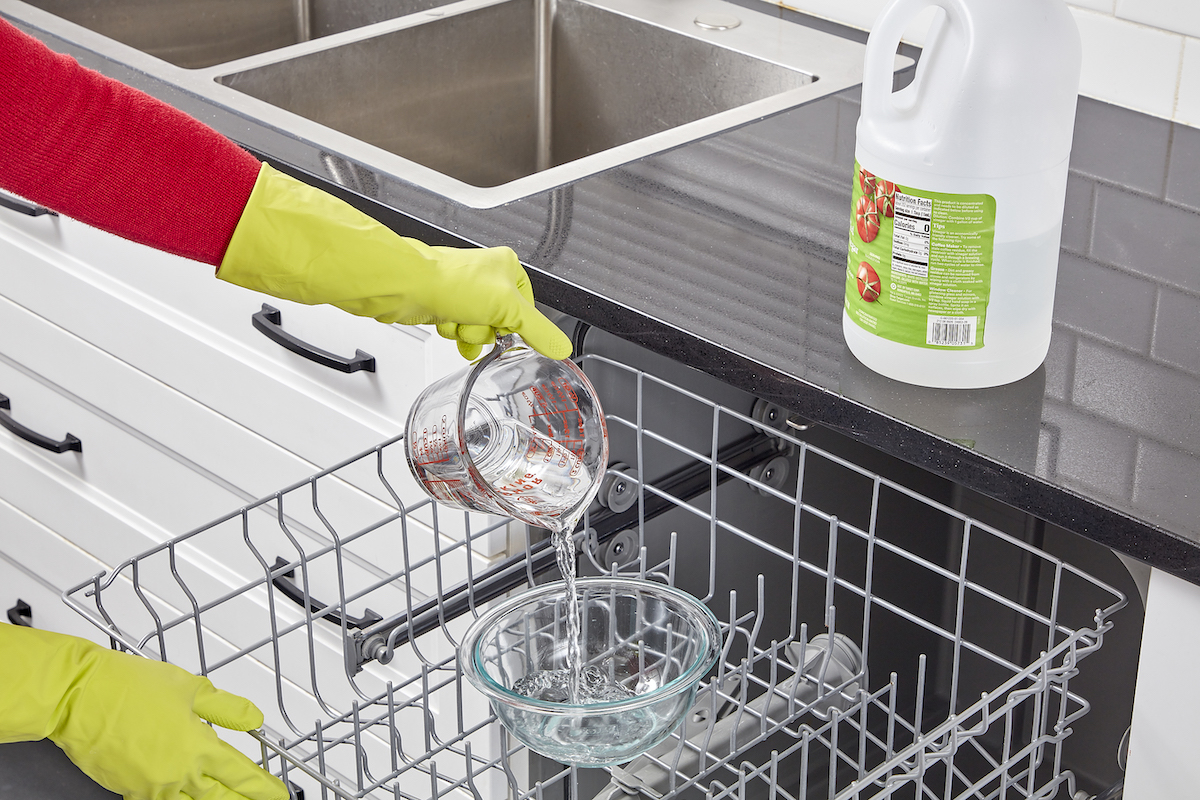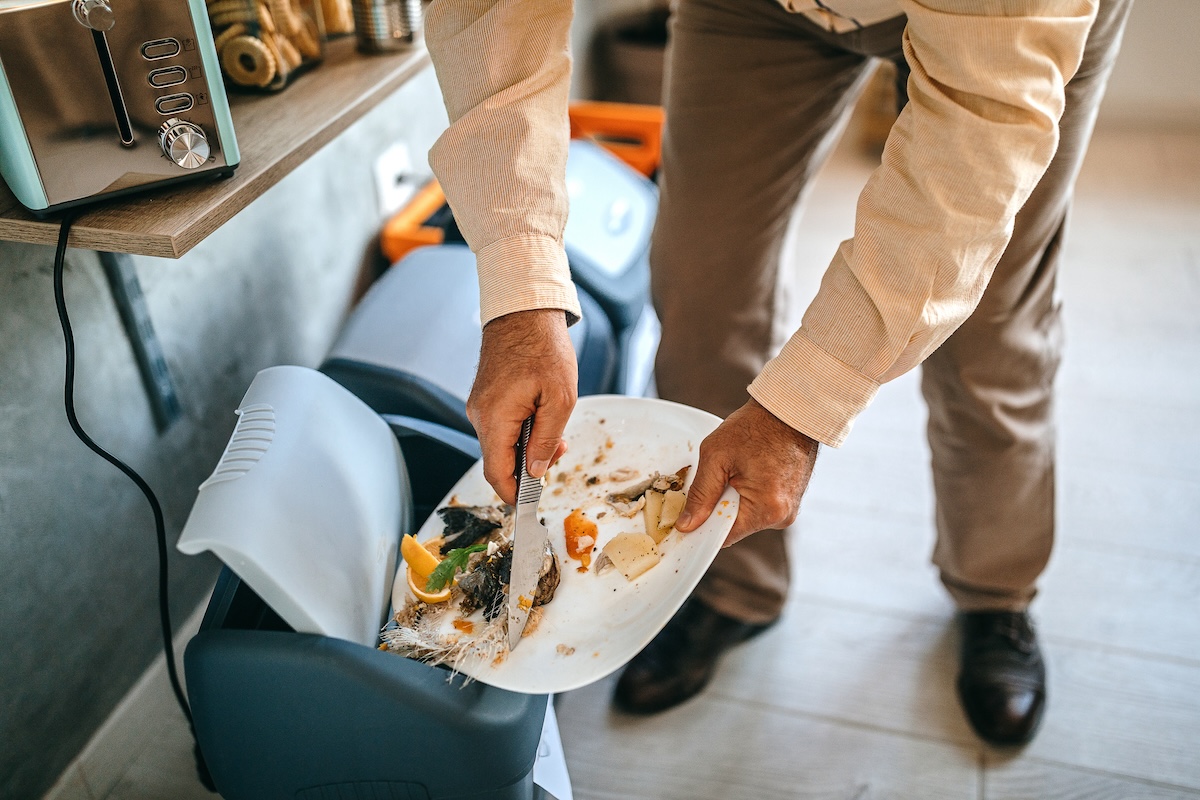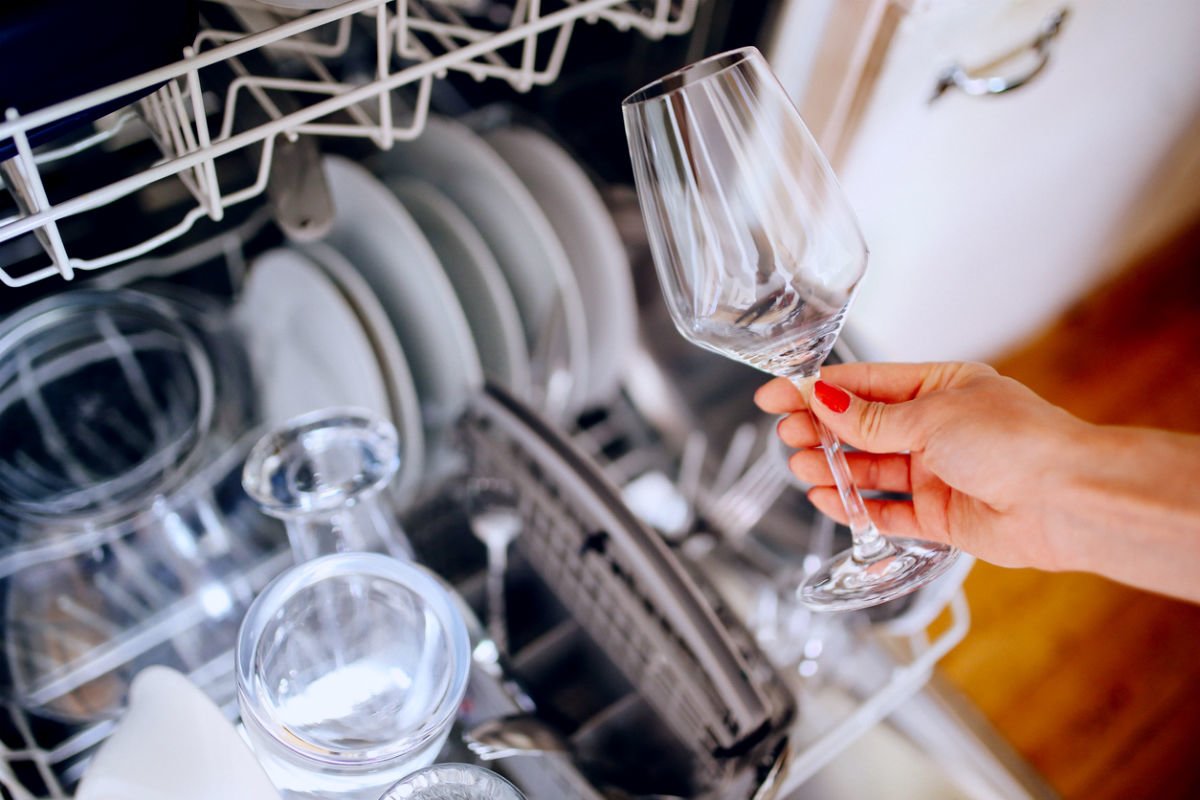We may earn revenue from the products available on this page and participate in affiliate programs. Learn More ›
Even a dishwasher that’s performed valiantly for years can suddenly slip, leaving you with food residue or a gritty film on your dishes. If your dishwasher is not cleaning dishes properly, there are several potential causes. The good news is that there’s no reason to rush out and buy a new appliance. Many of these issues can be addressed with simple DIY fixes.
Matthew Morrison, appliance expert at JustAnswer, suggests, “Always check the water first. Open the door after the wash cycle has run for a few minutes. The water level should be … at least a few inches deep.” If water isn’t flowing into the appliance, you’ll need to troubleshoot that problem. But if the water level is fine, move on to check these other common issues that can lead to a dishwasher not washing properly and find a few simple solutions that will get your dishes sparkling clean again.
Why Your Dishwasher Isn’t Getting the Dishes Clean
The issues that might have to do with why your dishwasher is not cleaning properly are easy to identify and correct. Run through the signs to spot and the fixes for each before throwing in the towel and calling in a professional—or replacing the unit with a new dishwasher.
1. The filter is dirty.

Dishwashers are equipped with filters to trap or remove food debris. When the filter becomes clogged, the dishwasher can recirculate dirty water, resulting in small bits of stuck-on food and potentially smelly dishes. While some dishwashers have self-cleaning filters, others have manual filters that need regular cleaning.
Find the filter on the bottom floor inside the machine. Consult the manufacturer’s instructions for removal and cleaning, but in many models, DIYers can remove them easily by rotating the cap a quarter turn to the left. To clean, pull out the lower rack, remove the filter, and rinse it under warm running water. For stubborn particles, soak the filter in warm water or rub it gently with a sponge or soft-bristle brush. For best results, clean the filter every month or two.
2. The dishwasher is dirty.

If gunk has accumulated in your dishwasher, you can often remedy the situation by running a cycle with vinegar. Pour about 2 cups of white vinegar into a dishwasher-safe bowl placed in the bottom rack of the appliance. (Some manufacturers specify the top rack.) Run a hot cycle, turning off the heated dry option if possible. The vinegar will dissolve light mineral buildup and clean deposits from the holes in the spray arm. It can also remove residual grease from the interior walls so dishes will come out cleaner and better smelling. Alternatively, some manufacturers recommend monthly use of a dishwasher cleaning product like Affresh or Finish dishwasher cleaner.
3. The spray arm is clogged.
Depending on the model, your dishwasher can have from one to three (or more) spray arms. Over time, these spray arms can crack or become clogged with mineral buildup, especially in homes with hard water, and lead to the dishwasher not cleaning dishes as it should. To clean the spray arms, check the manufacturer’s instructions for removal—the arms typically snap or twist off or can be removed by loosening a screw. Use a toothpick to clear the holes, and then rinse the spray arms under hot water. Soak heavily clogged spray arms in vinegar to help loosen the deposits.
4. The water isn’t hot enough.
Hot water is vital for dissolving food particles, so many dishwashers have heating elements that bring the water to the ideal temperature. If your dishwasher doesn’t have this feature, it’s drawing water from the hot water supply. To make sure that the water’s hot enough, keep your water heater set to 120 degrees, and before starting a load, run the hot water in the kitchen sink for a minute so that hot water begins to enter the machine sooner.
5. You’re not scraping dishes before loading.

Most dishwasher manufacturers (and the U.S. Department of Energy) advise against rinsing dishes before putting them in the dishwasher. Pre-rinsing is a waste of time, water, and energy, and it can hamper your dishwasher’s optimal performance, especially if it senses the dishes already are clean. But before putting dishes in the appliance, scrape off any large chunks of food that could clog the filter or gunk up the dishes. Remember: A dishwasher is not a garbage disposal. Although some models contain macerators that can grind up small bits of food, scraps of large or hard food can overwhelm the macerator, so a good scrape is the best practice.
6. You’re not loading dishes properly.
No matter what type of dishwasher you own, you’ll get the best results if you load the dishwasher correctly. For instance, large, improperly placed items can keep the spray arms from rotating. This prevents water from reaching the dishes, resulting in a dishwasher not cleaning well. If the dishwasher is not cleaning top rack items effectively, it’s especially worth confirming that the spray arms can spin freely and aren’t blocked. Other loading missteps, such as nesting cutlery or general overcrowding, can also lead to stuck-on food deposits.
7. You’re not using the right detergent.

Dishwasher detergent contains a blend of enzymes, detergents, and rinse aids that work together to dissolve food deposits and reduce hard water stains on glassware. For sparkling results, use a dishwasher detergent with a great track record, such as Cascade Platinum ActionPacs, which made the Consumer Reports “recommended” list. Amazon buyers give it a hearty 4.8 stars for cleaning power. If you use a gel or powder instead of a pod, don’t use too much or too little, and never use liquid dish soap in a dishwasher.
8. You’re not using a rinse agent.
Using a rinse agent can mean the difference between cloudy, dull dishes and crystal-clear results. These liquid additives contain surfactants designed to prevent water droplets from leaving spots. Depending on how often you run your dishwasher, you may need to top off the rinse aid every 3 to 4 weeks. If the rinse aid dispenser is full but you still find film on your dishes, check that the dispenser is securely closed and isn’t leaking.
9. You need to replace the dishwasher’s inlet valve.
If the dishwasher is not cleaning dishes even after you’ve completed the troubleshooting above, the inlet valve—which lets water flow into the dishwasher—could be failing. A hammering noise during a cycle is an indication of this problem. Many homeowners opt to call a technician at this point, but if you’re the DIY type, consult your owner’s manual. It will list the replacement valve you’ll need to order and might provide instructions for replacing the old one. (Morrison notes that sometimes the inlet valve is fine but the valve screen is clogged and just needs to be cleaned.)
10. You need to install a water softener.

Hard water can leave unattractive residue on plates and glassware. It can also leave deposits on the dishwasher, reducing the spinning of the spray arms and blocking the valves. If you suspect you have hard water, test the water with a kit like the Hach Total Hardness Kit. If it turns out you do have hard water, consider installing a water softener at your home’s water supply line. The softener will protect your dishwasher and make it easier to maintain, plus it will reduce hard water deposits on sinks, tubs, and showers.
When to Call an Appliance Professional
Even after trying a few fixes, you might still be left wondering, “Why is my dishwasher not cleaning?” If you’ve run through the checklist and still can’t correct the problem, it’s probably time to call in a repair person. But first, Morrison cautions, “consider the age of the machine… for anything near the 10-year-old point, I would suggest replacement over repair.”
As with many appliances around the house, prevention is the best strategy. Your dishwasher is more likely to work effectively if you keep it clean and adhere to the manufacturer’s operating instructions, including using the right type and amount of detergent, loading the dishes properly, and adding a rinse aid. Also, avoid putting certain items into the dishwasher: for instance, large pans that can interfere with the rotation of the spray arms and adhesive labels that can peel off jars and clog the filter. A little care and maintenance will help your dishwasher do its job, rewarding you with spotless dishes, cycle after cycle.


